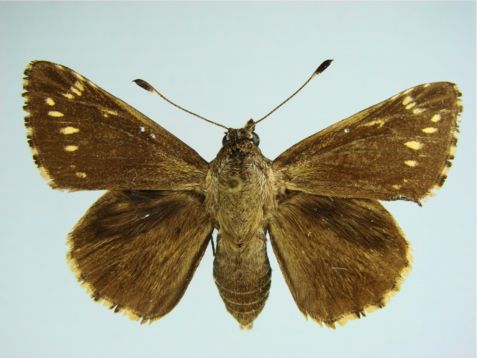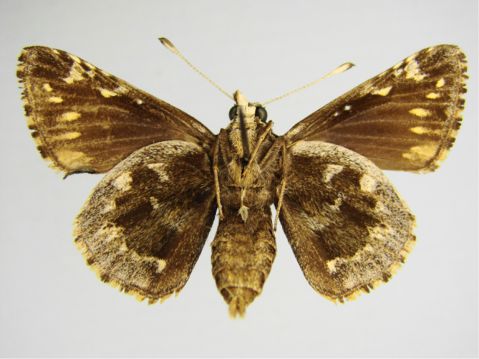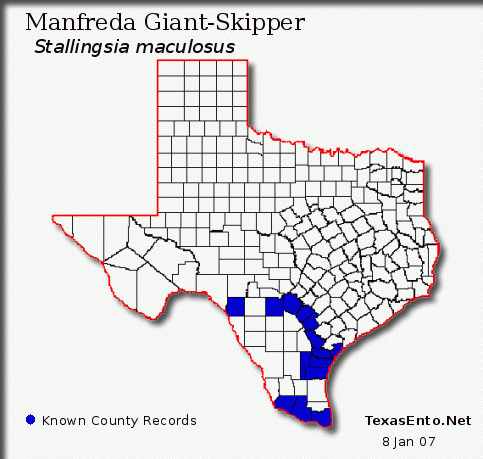 |
 |
Female - Dorso, Verso
S of Premont,
Jim Wells Co., TX
6-13-IV-1980 leg E. Knudson
Photographs Courtesy Texas Lepidoptera Survey
--- Rarest resident butterfly of South Texas ---
Return to Texas Entomology - Compiled by Mike Quinn
 |
 |
Female - Dorso, Verso
Photographs Courtesy Texas Lepidoptera Survey
--- Rarest resident butterfly of South Texas ---
 |
New County Records, Aransas, Bee, & Medina per Texas
Lepidoptera Survey.
Starr County added per correspondence to TPWD from H. A. Freeman.
Range:
Texas counties: Aransas, Bee, Bexar, Cameron, Hidalgo, Jim Wells, Karnes, Kinney, Kleberg, Medina, Nueces, San Patricio, Starr, and Wilson.
Mexico: The only Mexican location where this species has been found was 35 miles southwest of China, Nuevo Leon. (Freeman, 1969).
Type Locality: 2 miles south of Kingsville, Kleberg Co., Texas. Elevation 100 ft. Soil pH 7.0. (Freeman 1963)
Life History:
Early on, Freeman (1969) reported S. maculosus to be the only Megathymid known to be double brooded. He collected pupae in April that emerged in May, while most of his specimens emerged during September and October. Charles Bordelon & Terry Doyle (pers. comm., Jan 2007) report that Agathymus estelleae valverdiensis is also double brooded.
This species is highly local and non-migratory. Adults do not feed and are short lived. However, like other Giant-Skippers, the males probably take moisture and salts from moist soil. Females glue eggs singly to the caterpillar food plant. Young caterpillars bore into the root or leaves, a behavior unique among butterflies, though common to all Giant-Skippers. Caterpillars make silk "chimneys" or "tents" which project from the plant, in which they feed, overwinter (if fall generation), and pupate. The pupae can move up and down within their burrows.
sourseThe summer generation develops directly to adult without aestivation. The fall generation overwinters as caterpillars, probably third instars. (Vaughan & Shepherd, 2005)
See similar chimney or tent photos of the Yucca Giant-Skipper (Megathymus yuccae)
Also, see line drawing of a Megathymus tent, tunnel and larva in Scott (1986) on page 417.
In addition, there is excellent life history information and photos of the Yucca Giant-Skipper in Minno & Minno (1999) on pp. 140-142.
Flight Period:
There are 13 specimens collected between 1962 and 1965 as egg, larva, or pupa in the Roy O. and Connie A. Kendall Collection of Lepidoptera curated at the TAMUIC, College Station, Texas.
Dates:
2 - May 1-3
9 - September 3-18
2 - October 1-2Locations:
4 - Harlingen City land fill, Cameron Co.
5 - US Hwy. 22, ca 2 mi. S Kingsville, Kleberg Co.
2 - University of Corpus Christi campus, Nueces Co.
2 - S of Taft, Nueces Bay area, San Patricio Co.
Taxonomy:
There are three species of Stallingsia:
Stallingsia jacki D. Stallings, Turner & V. Stallings, 1963
Stallingsia maculosus (H. Freeman, 1955)
Stallingsia smithi (H. Druce, 1896)S. jacki and S. smithi have limited distributions in Mexico.
Scott (1986) treats Stallingsia maculosus as a subspecies of the Mexican Stallingsia smithi. Most other workers treat them as separate species.
Etymology:
Genus named for Don B. Stallings, noted Lepidopterist and Giant-Skipper expert. (Freeman, 1959a)
Notes:
Undated, hand written note by H. A. Freeman in TPWD Wildlife Diversity Program files states:
"When I first discovered this butterfly in 1951 at Parita Creek, Bexar Co. and during 1952 located colonies at Falls City, Sinton, Kingsville, Mission, Sullivan City and just east of San Antonio, it was fairly common at all locations. Soon after I named and described this species in 1955, I started visiting the locations where I had first collected it and found that several habitats had been destroyed by progress ? such as new roads, buildings, overgrazing and other methods that had destroyed the larval food plant. The last time that I tried to find specimens none were to be found. This is not to say that they are all gone but care should be taken in collecting them."
In a 29 June 1991 typed letter from Roy O. Kendall to TPWD Wildlife Diversity Program, Roy lists 21 dates on which S. maculosus was collected across south Texas from 1951 to 1965.
Two records predate Freeman's first find of the species. An adult male was collected in east Bexar County, Texas on 31 Nov 1935, ex larva, and is in the Los Angeles County Museum.
Amazingly, 71 years before Stallingsia maculosa was described, the first specimen was collected on the Nueces River near Corpus Christi, Nueces Co., TX by S. F. Aaron in 1884.
Nick Grishin reported (2003) having searched all the old locations and found "no signs of the bugs and very few remaining Manfreda plants."
The most recent, verified Manfreda Giant-Skipper records are from 1980.
Conservation Status:
See: Fish and Wildlife (1994), NatureServe (2006), Vaughan & Shepherd (2005).
Caterpillar Host Plant:
The larvae feed in the caudex of Manfreda maculosa Hooker. pH of soil, 7-7.3 in areas where larvae were collected. (Freeman, 1969). Manfredas don't tolerate overgrazing nor do they readily come back after such conditions.
Plant Taxonomy: per Jones et al. 1997.
Manfreda maculosa (W. Hooker) J. Rose
Orig. Comb: Agave maculosa W. Hooker
Syn: Polianthes maculosa (W. Hooker) L. ShinnersAgavaceae - Century-plant family
(Formerly placed in the Liliaceae and Amaryllidaceae families)Common Names: Texas Tuberose, Spice Lily, American Aloe, False Aloe, Liver-spotted Aloe
Distribution:
Specimens collected from south Texas and just across the Rio Grande near Mier and Reynosa, Tamaulipas. Only three examples have been collected deeper inside Mexico, from near Sabina, Coahuila, from Monterrey, Nuevo Leon, and at a hacienda southwest of Monterrey, near San Juan, Nuevo Leon. (Verhoek-Williams, 1975)
Texas County records for Manfreda maculosa:
Habitat:
The preferred habitat of this plant species is sand, sandy loam, sandy clay, or clay soils; in mesquite scrubland, in both moist and dry sites. (Verhoek-Williams, 1975)
Flowering:
April through October. There seems to be a peak flowering period in May and June. In the greenhouse, plants have bloomed in late October and in early and late May. (Verhoek-Williams, 1975)
Weblinks:
South Texas Manfreda Conservation Survey - NABA
Texas Manfreda spp. photos - NABA-SoTX
Manfreda maculosa photos and habitat shots - second set of photos - Butterflies of America (BOA)
Manfreda spp. county range maps - The Biota of North America Program (BONAP)
Info Page - BugGuide
Manfreda maculosa - Lady Bird Johnson Wildflower Center (LBJWC)
PLANTS Profile - USDA Plants Database
References:
Aaron, S.F. 1885. Collecting on the Gulf Coast of southern Texas. Papilio 4(9-10): 159-161.
Correll, D.S. & M.C. Johnston. 1970. Manual of the vascular plants of Texas. Renner: Texas Research Foundation. 1881 pp.
Damude, N. & J.M. Poole. 1990. Revised status report on Manfreda longiflora (Polianthes runyonii). Report prepared for the U.S. Fish and Wildlife Service, Alburquerque, New Mexico.
Druce, H.H. 1896. Insecta. Lepidoptera-Heterocera. Published for the editors by R.H. Porter, London. Vol. 2: 320. pl. 69, fig. 6.
Enquist, M. 1987. Wildflowers of the Texas Hill Country. Lone Star Botanical, Austin. 275 pp.
Fish and Wildlife. 1994. Endangered and Threatened Wildlife and Plants; Animal Candidate Review for Listing as Endangered or Threatened Species. Federal Register.
Freeman, H.A. 1951. Notes on the Agave feeders of the genus Megathymus. Field and Laboratory, 19(1): 26-32.
Freeman, H.A. 1955. Four new species of Megathymus (Lepidoptera, Rhopalocera, Megathymidae). American Museum Novitiates, 1711: 1-20.
Freeman, H.A. 1959a (1958). A revision of the genera of the Megathymidae, with descriptions of three new genera. The Lepidopterists' News, 12(3/4): 81-92.
Freeman, H.A. 1959b. Butterfly collecting in Texas and New Mexico. Journal of the Lepidopterists' Society, 13(2): 89-93.
Freeman, H.A. 1963. Type localities of Megathymidae. The Journal of Research on the Lepidoptera, 2(2): 137-141.
Freeman, H.A. 1969. Systematic review of the Megathymidae. Journal of the Lepidopterists' Society, 23 (Supplement 1): 1-62.
Groman, J.D. & O. Pellmyr. 1999. The pollination biology of Manfreda virginica (Agavaceae): relative contribution of diurnal and nocturnal visitors. Oikos, 87(2): 373-381.
Hooker. 1903. Contributions from the United States National Herbarium, 8(1): 17.
Jones, S.D., J.K. Wipff, & P. M. Montgomery. 1997. Vascular Plants of Texas: A Comprehensive Checklist including Synonymy, Bibliography, and Index. University of Texas Press, Austin. 416 pp.
Minno, M.C. & M. Minno. 1999. Florida Butterfly Gardening: A Complete Guide to Attracting, Identifying, and Enjoying Butterflies of the Lower South. University Press of Florida. 224 pp.
NatureServe. 2011. Stallingsia maculosus (H. Freeman, 1955). NatureServe Explorer: An online encyclopedia of life. Arlington, VA.
Neck, R.W. 1996. A Field Guide to the Butterflies on Texas. Gulf Publishing Co., Houston. xvii + 323 pp.
Preston, J.D. 2005. Collecting butterflies with a shovel and crowbar. Southern Lepidopterists' Society, 27(4): 106-108.
Roever, K. 1975. Family Megathymidae. Pp. 411-422 in: W.H. Howe, editor. The Butterflies of North America. Doubleday and Co., Garden City, New York. xiii + 633 pp., 97 pls.
Scott, J.A. 1986. The Butterflies of North America, a Natural History and Field Guide. Stanford University Press, Stanford. xiii + 583 pp.
Shinners, L.H. 1966. Texas Polianthes, including manfreda (Agave subgenus manfreda) and runyonia (Agavaceae). Sida, 2(4): 333-338.
Stallings, D.B. & J.R. Turner. 1957. A review of the Megathymidae of Mexico with a synopsis of the classification of the family. The Lepidopterists' News, 11(4-5): 113-137.
Stallings, D.B., J.R. Turner, & V.N. Stallings. 1963. Two new species and one new subspecies of Megathymidae from Mexico and Texas. Journal of the Lepidopterists' Society, 17: 109-115, 2 pis.
Vaughan, D.M., & M.D. Shepherd. 2005. Species Profile: Stallingsia maculosus. In: Shepherd, M.D., D.M. Vaughan, & S.H. Black (Eds). Red List of Pollinator Insects of North America. CD-ROM Version 1 (May 2005). The Xerces Society for Invertebrate Conservation, Portland.
Verhoek-Williams, S.E. 1975. A study of the tribe Poliantheae (including manfreda) and revisions of manfreda and prochnyanthes (Agavaceae). Ph.D. Thesis: Cornell University, Ithaca, New York. 405 pp.
29 March 2020 © Mike Quinn / entomike@gmail.com / Texas Entomology / Texas Lep Information